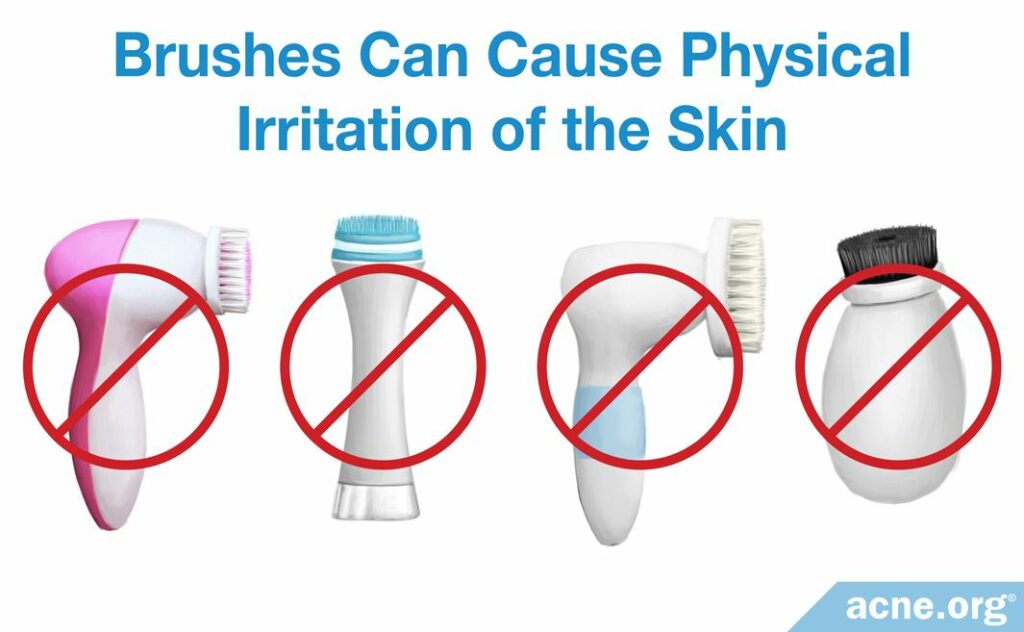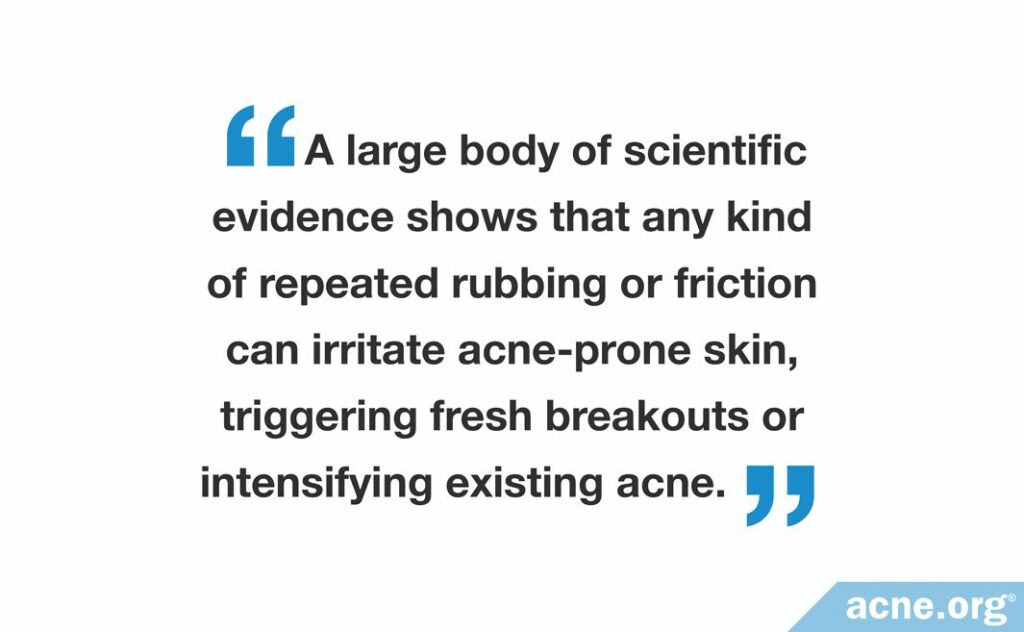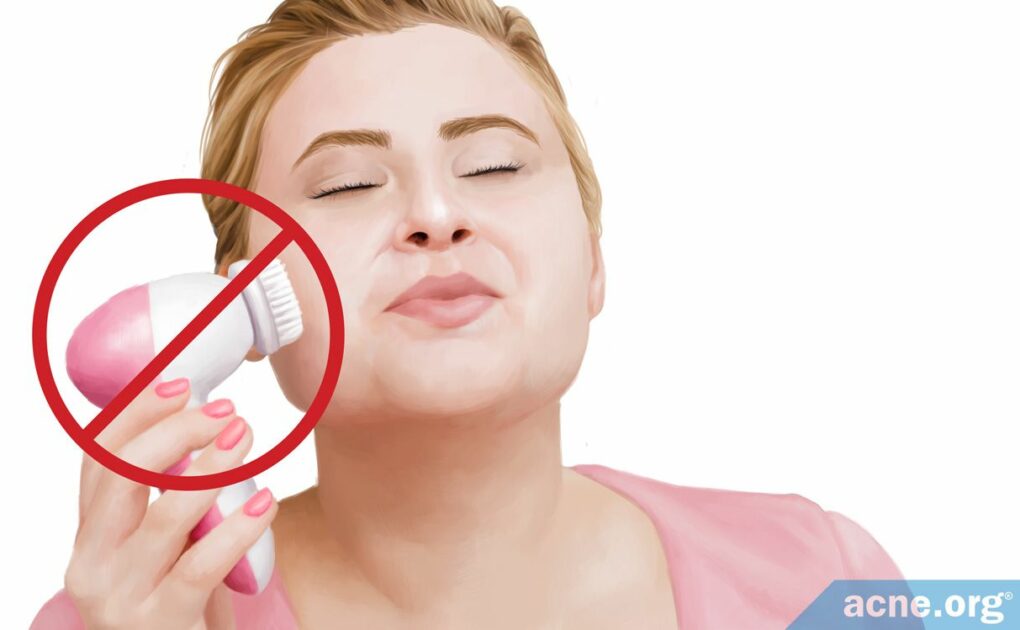Spinning Brushes Irritate the Skin and Can Make Acne Worse

The Essential Info
Spinning face brushes are made from a variety of materials. What they have in common is the advertised promise to “thoroughly cleanse the skin, helping to reduce acne.” However, the only evidence behind this claim comes from studies supported or sponsored by large cosmetics companies.
In reality, the repeated rubbing motion of spinning brushes irritates the skin and can trigger breakouts and make existing acne worse. This is true of even the gentlest varieties of these spinning brushes.
Instead of using a spinning brush, wash your face using only your bare hands and a gentle facial cleanser for 10 seconds or less to minimize skin irritation.
If You Just Can’t Give It Up: If you simply love your spinning brush and can’t live without it, press as lightly as possible and for as short a time as possible each time you use it.

The Science
Spinning face brushes, also known as cleansing brushes, are brushes with a rotating head for cleansing the face. Many spinning brushes have a hollow brush head that can be filled with cleanser and water, so that as the brush spins, it simultaneously dispenses cleanser onto the skin surface.
These brushes can be made from natural or synthetic materials, and can have bristles or flat cushioned heads on them.
You may have heard that spinning brushes are beneficial for people with acne. In fact, some manufacturers even produce spinning brushes targeted specifically to consumers with acne. However, the only scientific evidence supporting the use of spinning brushes on acne-prone skin comes from studies supported or sponsored by large cosmetics companies.1-4 Unless independent researchers conduct reliable studies and confirm these findings, we will have no reason to believe that spinning brushes are a good idea for people with acne. Based on everything we know about how acne develops, spinning brushes do more harm than good for acne-prone skin. Let’s take a closer look at why that is.
What Is the Purpose of a Spinning Brush?

Spinning brushes are advertised as providing a “deep cleanse.” However, this is a misconception because it is easy to get a thorough cleanse using only your bare hands and a gentle cleanser. You don’t need to “brush” your skin to get your skin completely clean.
Manufacturers also claim that spinning brushes can “tighten pores” and “improve circulation,” but these marketing assertions are also not backed by science.
When it comes to acne, advertisers suggest that spinning brushes can help with acne by removing dead skin cells, thus exfoliating the skin. While it is true that exfoliation can help with acne, spinning brushes accomplish this the wrong way–by physically rubbing the skin. Anything that physically rubs against the skin can in fact lead to more acne. This is why people with acne-prone skin should chemically exfoliate the skin instead, using an alpha or beta hydroxy acid (i.e. glycolic acid).
The types of spinning brushes: It comes down to bristle type and speed
Spinning brushes can come in different shapes, but the main differences between them are the:
- Type of brush head:
Nylon bristles are better at reaching every nook and cranny of your face, but can be difficult to clean and can allow bacteria to accumulate.
Silicone bristles are thicker and are therefore worse at reaching every nook and cranny, but are easier to clean and harbor less bacteria.
Cushioned, gel-based flat-head brushes provoke less irritation and are easy to clean.
- Number of speeds:
Two-speed brushes are the most common and allow you to choose between a gentler and more vigorous cleanse.
Three- or four-speed brushes are less common and include additional speeds for an even more vigorous cleanse.
While the cheapest spinning brushes tend to come with only one brush head with nylon bristles and two speeds, the more expensive models often include several interchangeable brush heads with different bristle types as well as three or four speeds.
Spinning Brushes Can Trigger Acne Flare-ups

By design, spinning brushes repeatedly rub the skin in a circular motion while distributing water and cleanser around the face. A large body of scientific evidence shows that any kind of repeated rubbing or friction can irritate acne-prone skin, triggering fresh breakouts or intensifying existing acne.5,6
So far, there are three studies that have looked specifically at spinning brushes and acne. Although the studies show significant improvement in acne after using spinning brushes for a couple of weeks, we cannot rely on them. The design of the studies was poor with major limitations that should be taken into consideration. These limitations include:
- Large cosmetic companies supported or sponsored the studies.2-4
- All of the studies included only a small number of people with acne.2-4
- One of the studies didn’t even employ any controls, so there is nothing to compare results against.4
The reality of spinning brushes may in fact be the direct opposite of what these sponsored studies are showing. For example, a different study found that frequent use of a hair brush can trigger scalp acne.7 This makes sense because we know that physical irritation of the skin can lead to more acne. Would the same be true for a spinning brush? It is likely.
If you would still like to try a spinning brush, look for a brush with very soft nylon bristles and use it only on the slowest speed to minimize irritation. Use it only for a short period of time, and don’t press too hard.8 Make sure to clean the brush thoroughly and air-dry it after each use to avoid buildup of bacteria on the brush.
However, the best rule of thumb is to avoid using any kind of spinning brush. Instead, simply wash your face with your bare hands using a gentle facial cleanser, and only wash for 10 seconds or less. This is the best way to cleanse your skin without triggering a breakout.
References
- Gold, M. , Ablon, G., Andriessen, A., Goldberg, D., Hooper, D. & Mandy, S. Facial cleansing with a sonic brush-A review of the literature and current recommendations. J Cosmet Dermatol. 18, 686‐691 (2019). https://pubmed.ncbi.nlm.nih.gov/30985993/
- Tadlock, L., Rapaka, S., Alejandro. N., et al. A multicenter clinical trial to evaluate the safety and efficacy of two OTC acne regimens comparing sonic to manual cleansing in individuals with mild to moderate acne vulgaris. J Am Acad Dermatol. 74, AB1 (2016). https://www.jaad.org/article/S0190-9622(16)00132-8/fulltext
- Henes, E., Ortblad, K., Kearney, M., Koski, N. & Tadlock, L. Efficacy and safety of a novel sonic brush head designed for cleansing acneic skin. J Am Acad Dermatol. 68, AB14 (2013). https://www.jaad.org/article/S0190-9622(12)01341-2/fulltext
- Gold, M.H. et al. A cohort study using a facial cleansing brush with acne cleansing brush head and a gel cleanser in subjects with mild-to-moderate acne and acne-prone skin. Journal of Drugs in Dermatology 18,1140-1145 (2019). https://pubmed.ncbi.nlm.nih.gov/31741359/
- Mills, O. & Kligman, A. Acne mechanica. Archives of Dermatology 111, 481-483 (1975). https://www.ncbi.nlm.nih.gov/pubmed/123732
- Tan, S. et al. Acne mechanica. British Medical Journal 1, 130 (1976). https://www.bmj.com/content/bmj/1/6002/130.1.full.pdf
- Petrozzi, J.W. Comb and brush acne. Cutis 26(6), 568-71 (1980). https://www.ncbi.nlm.nih.gov/pubmed/6449356
- Akridge, R.E. & Pilcher, K.A.. Development of sonic technology for the daily cleansing of the skin. Journal of Cosmetic Dermatology 5, 181-183 (2006). https://pubmed.ncbi.nlm.nih.gov/17173597/
 Acne.org Products
Acne.org Products